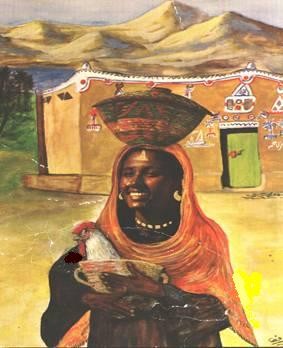|
In Nubia all the land nearest the river is
intensely farmed and irrigated; vegetables are even planted at
the bases of date palms and fruit trees to maximize land use. In
ancient times the growing of crops was possible only during the
early fall, after the summer rains and after the Nile had
flooded its banks. As the water gradually receded, farmers could
raise less and less water to the fields, and thus little more
could be grown until the following year. With the invention of
the shaduf (the water lift) about 1600 BC and the saqia (the
ox-driven waterwheel) in Roman times, some land could be
irrigated even during the dry season, and this resulted in
limited but continuous crop yield. Today such primitive machines
have been replaced by motorized pumps, which make full-scale
agriculture possible all year round.
.
 The most notable features of the Nubian Nile
are its frequent stretches of rocks and rapids, called
"cataracts", of which (before the Aswan Dam) there were six
numbered cataracts between Aswan (the First Cataract) to
Shabaluka Gorge (the Sixth, about 40 miles [66 km] downstream
from Khartoum). The most notable features of the Nubian Nile
are its frequent stretches of rocks and rapids, called
"cataracts", of which (before the Aswan Dam) there were six
numbered cataracts between Aswan (the First Cataract) to
Shabaluka Gorge (the Sixth, about 40 miles [66 km] downstream
from Khartoum).
The Nubians have traditionally lived on the banks of the Nile
southern Egypt and northern Sudan . They continue cultural
practices which originated with their ancestors over 5,000 years
ago in the age of the ancient Nubian kingdom . Nubian life
revolves around the Nile River. The Nile provides water for
drinking, washing, agriculture, In appreciation for the benefits
of the Nile. the entire village gathers by the river during
ceremonies such as birth, weddings , circumcisions, and harvest
festivals
Life in Nubia was oriented by a continuous
round of ceremonial activities. Dr John Kennedy in " Nubian
ceremonial life " The amount of time, effort and money spent
upon ceremonialism was so great that it is no exaggeration to
say that ritual activities dominated Nubia cultural life. It is
also apparent that adaptation of ceremonialism have features of
Nubian life for centuries, and that these people have been
extremely receptive to ideas and practices from elsewhere. This
tendency towards syncretism and assimilation in ceremonial
customs reflects the intense involvement of Nubian action and
though with the supernatural , and it is my opinion that if one
does not understand this complex ritual system one can make no
beginning at the comprehending of Nubian behavior and culture,
or the changes occurring in them.
Marriage and the river
On the afternoon of the wedding day the groom sat on a mat and
dyed his hands, feet, and forehead with henna ( reddish-brown
dye stuff) after that he went to the river and washed the henna
off his hands, feet and forehead because washing in the river
helped to ensure the groom's ability to procreate children,
since fertility was one of the attributes most persistently
associated with the river
Death and the river
Death ritual related to the river took place on two different
days once at noon of death and once again on (Kobar day ). On
both days women went to the river together and washed their
faces. After washing they sat for a few minutes by the river,
leaving their faces wet. This allowed the corpse to relax in its
grave and cool the body of the deceased
Birth and the river
On the fortieth day the mother went to the river with the baby
.Then she washed the baby's face, hands and legs in the river
and filled five gallon tins with water so that she could have
her Arbain ( forty day ) bath at home , a ritual which
involved pouring forty tins water over herself . The water used
in that ritual were thought to be blessed
The annual Islamic ceremonial cycle
The annual Islamic ceremonial cycle also showed theme of river
related activities
Ashura and the river
Ashura is an Islamic rite held on the tenth day of the Arabic
month of Muharram in memory of the martyrdom of the prophet's
grandchildren. Women and children burned ropes after dark and
ran to the river. There each put together some stones symbolic
of his or her household. The number being equal to the number of
family members to provide them the river blessing
The Mawlid and the river
The Mawlid is an Islamic ceremony on a Sheik's birthday. The
keswa ( cloth covered for the shrine in a Sheikh's tombs) was
carried in a procession to the river. The men dived with it into
the river and the women squeezed water from the cloth for
everyone to drink for blessing
|